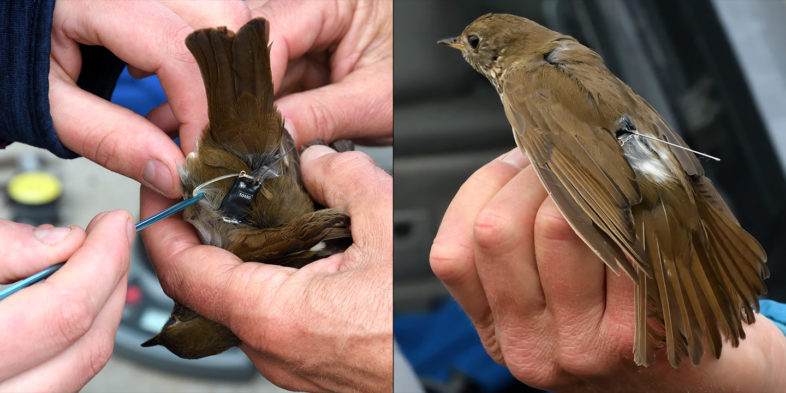
An adult Bicknell’s Thrush receives a tiny GPS tag “backpack” (left) and is ready to go moments later (right). An unwitting participant in VCE’s new study to document pre-migratory, late winter movements on the species’ Greater Antillean wintering grounds, this bird will yield its geospatial secrets when it returns to Mansfield in June of 2022. © Michael Sargent
No one has ever questioned the superior ability of songbirds, most weighing one ounce or less, to outshine ornithologists when it comes to handling rugged mountain weather. VCE’s Week 4 field session on Mt. Mansfield underscored this adage. While our skeleton crew of 4 layered up, pounded calories, shivered, and occasionally whined, the birds we study there—led by Bicknell’s Thrush (BITH)—put on a show, and put us to shame.
We arrived at our long-term study site in late afternoon on 22 June, finding the ridgeline bathed in clouds, pinned down by a brisk north wind, temperatures in the mid-40s F. With no rain in the forecast, we set our mist nets as usual, extending south to an area on the Forehead, where we hoped to intercept some naive BITH for GPS tagging. Conditions were hardly conducive to success, as nets billowed in the wind, constantly accumulating a veneer of fine droplets combed from the clouds. Signs and sounds of avian life were few.
Yet, the mist net captures started and kept coming. By nightfall, we had processed 22 birds, including 7 BITH (5 males and 2 females with fully-developed incubation patches, indicating active nesting), 6 of which flew off with tiny GPS backpacks. Encouragingly, the seventh BITH was a male that we had tagged on 8 June—we were pleased (and relieved) that he appeared in robust condition, having gained 3.1 grams since his original capture two weeks earlier. We banded the evening’s last bird, a Swainson’s Thrush, at 10:30 pm and cocooned ourselves into sleeping bags in the parking lot.
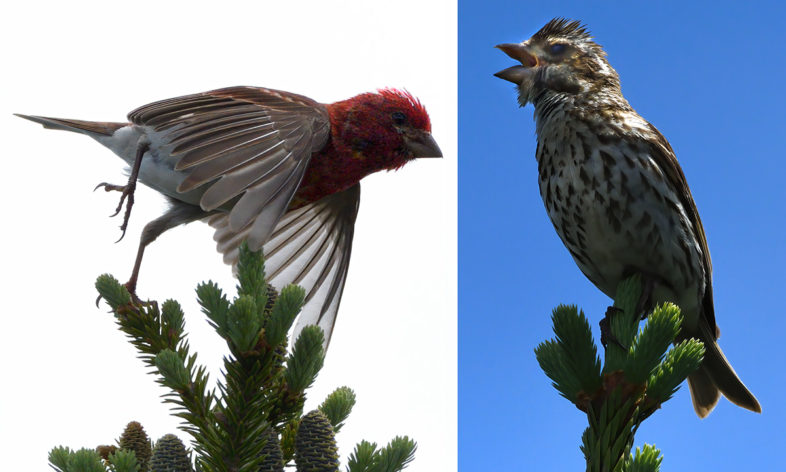
Purple Finches (2+ year-old male on left, yearling male on right) were in strong voice around the Mansfield ridgeline during late morning on 23 June 2021. © Michael Sargent
A chilly 5 hours later, after stars made several fleeting appearances overnight, we crawled out of our cloud-soaked bags and were opening nets by 4 am. The dawn chorus was a whisper, and the ridgeline again a blanket of cold, wind-driven fog. But…birds cooperated, and we enjoyed a steady stream of captures through the morning, as temperatures ever so gradually rose (topping out at 48F) and winds diminished. BITH continued where they left off atop the leaderboard, with another 10 birds captured and another 4 GPS tags fitted. Two previously tagged birds—a male and a female—were hale and hearty, both having gained weight since being tagged 1-2 weeks earlier. Our total of 17 BITH captured very likely represented a single-visit record, and we’re now nearly halfway to our goal of fitting GPS tags to 40 adults birds this summer, with 19 on so far. Blackpoll Warblers followed close behind BITH, with 16 individual captures.
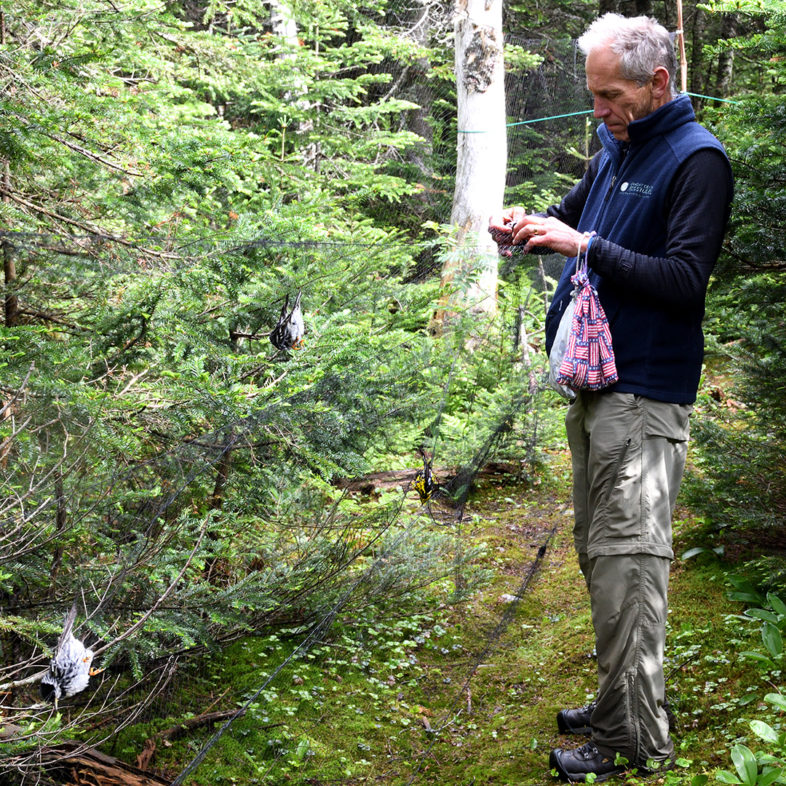
A trio of Blackpoll Warblers awaits extraction in a VCE mist net on the Mt. Mansfield Forehead, 23 June 2021.
To be fair, our new Forehead nets accounted for a disproportionate share of both species’ captures, but our final tally of 54 birds was very solid overall, though light on species diversity. Our total included:
Red-breasted Nuthatch — 1 new female with regressing brood patch
Bicknell’s Thrush — 17: 13 males and 4 females; 10 new, 4 returns (2 each from 2019 and 2020); 3 within-season recaptures; females with fully-developed incubation patches
Swainson’s Thrush — 2 new males
Purple Finch — 2 new; female with regressing brood patch and yearling male
Dark-eyed Junco (Slate-colored) — 5 (3 new, 2 within-season recaptures)
White-throated Sparrow — 5 ( new, return male from 2019, 2 within-season recaptures)
Blackpoll Warbler — 16: 12 males and 4 females; 12 new, 4 within-season recaptures; females with fully-developed incubation patches
Yellow-rumped Warbler (Myrtle) — 6 (5 new, 1 return male from 2020, 2 within-season recaptures)
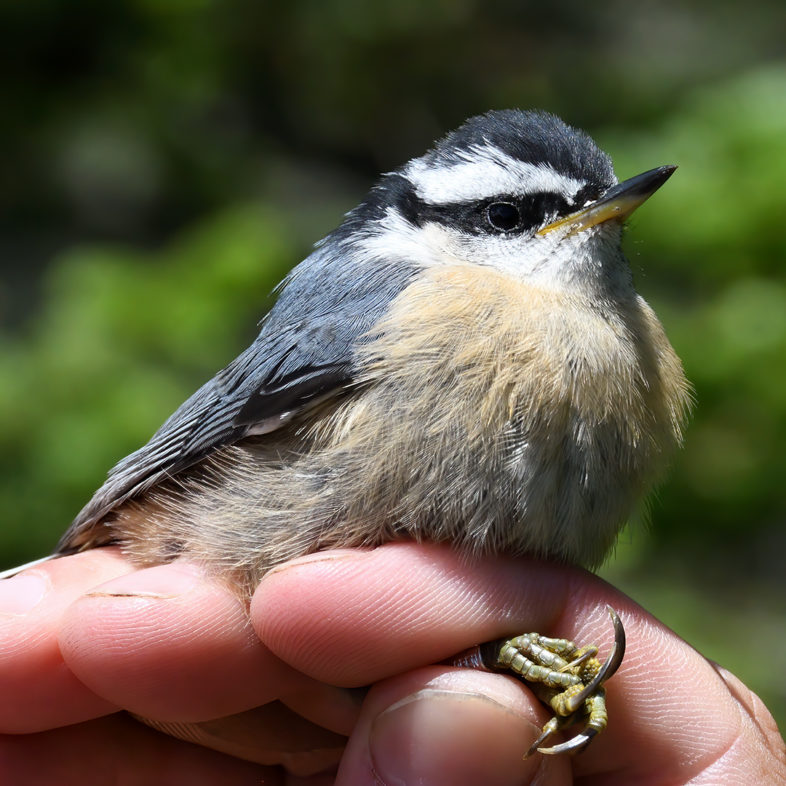
A Hatch-Year Red-breasted Nuthatch just prior to release after banding on Mt. Mansfield, 23 June 2021. © Michael Sargent
We were pleased to welcome Dr. Johanna Harvey, a postdoctoral researcher at the American Museum of Natural History to collaborate with us on Mansfield. Johanna is studying the effects of climate change on the distribution and virulence of avian malaria parasites, while also examining the associated host immune response. By sampling blood from resident and migratory passerine birds along a latitudinal (and now elevational) gradient on the East Coast, and assessing malarial parasite loads, Johanna’s goal is to examine whether malaria could be a factor in driving worrisome declines among birds of the Atlantic Flyway. We’ll welcome her back next week and hope to augment her sample of montane birds for this important project.
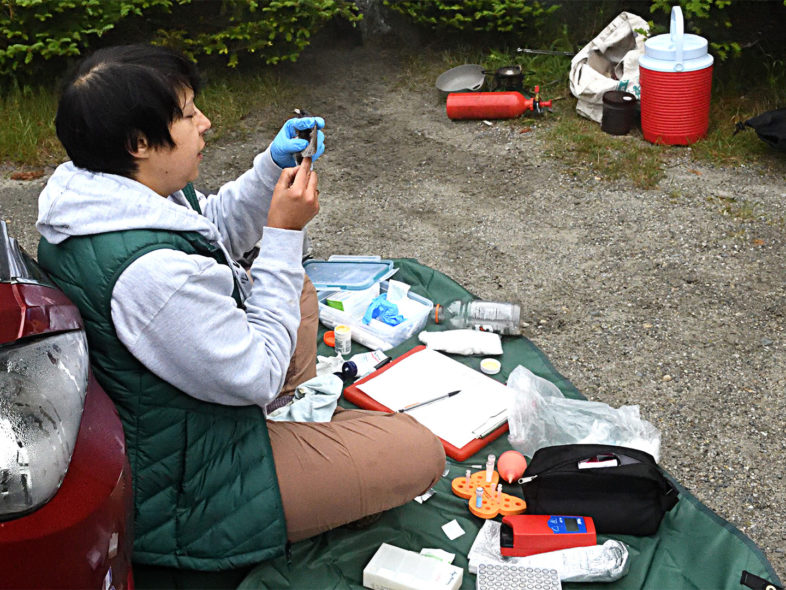
Dr. Johanna Harvey samples a banded Blackpoll Warbler for malarial blood parasites at the VCE banding station on Mt. Mansfield, 23 June 2021. Note the VCE coffee bar in background. © Michael Sargent

Just when I think the VCE avian science and writing couldn’t get any better you produce a piece like this, bringing to life what it’’s like to be on the mountain skillfully unlocking the geospatial secrets of songbirds. Obviously a rush for your team. I can almost smell the VCE bush coffee.
FYI
I feel like I was there! Oh yea I was in 2001? What a gift to hold a Bicknell Thrush in an early morning in June. Thanks for that experience Rim and keep up the good work. Good catch this year..congratulations!